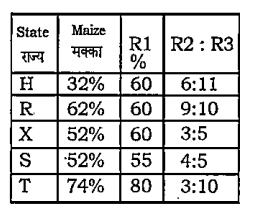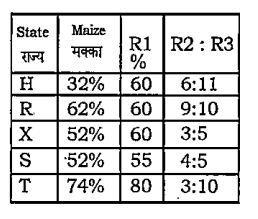एक्स-रे कूलिज ट्यूब प्रयोग एक्स-रे I v/s X ग्राफ के प्रकार
Step by step video solution for एक्स-रे कूलिज ट्यूब प्रयोग एक्स-रे I v/s X ग्राफ के प्रकार by Physics experts to help you in doubts & scoring excellent marks in Class 12 exams.
Updated on:21/07/2023समान प्रश्न
मोसले का नियम ऑफ एक्स-रे का विवर्तन ब्रैग का नियम डेविसन जर्मर प्रयोग
View SolutionThe table given below shows the, production of maize by 5 different states as a precentage of total production. Each state produces only maize and rice. There are three types of rice-R1,R2 and R3. The table also shows the R1 type of rice produced as a percentage of total rice production and the ratio of R2 and R3 type of rice. Total production by each state is 625000.
नीचे दी गई तालिका 5 विभिन्न राज्यों दवारा किए गए मक्के के उत्पादन को कुल उत्पादन के प्रतिशत के रूप में दर्शाती है। प्रत्येक राज्य केवल मक्का तथा चावल का ही उत्पादन करता है। चावल के तीन प्रकार-R1,R2 तथाR3 हैं। यह तालिका R1 प्रकार के चावल के उत्पादन को कुल चावल के उत्पादन के प्रतिशत के रूप मे दर्शाती है। R2 तथा R3 प्रकार के चावल के अनुपात को दर्शाती है। प्रत्येक राज्य दवारा कुल उत्पादन 625000 है। What is the total production of maize by the state S and R and
the total production of R2 types of rice by the state X and T?
What is the total production of maize by the state S and R and
the total production of R2 types of rice by the state X and T?
राज्य X तथा T द्वार मक्के का कुल उत्पादन तथा राज्य S तथा R द्वारा R2 प्रकार के चावल के कूल उत्पादन का योग क्या हे?
View Solution
ज्ञान जांच
एक प्रकाश विद्युत प्रयोग में, निरोधी विभव VS को आपतित प्रकाश की आवृत्ति v के विपरीत आलेखित किया गया। परिणामी वक्र एक सरल रेखा है जो v अक्ष के साथ कोण θ बनाती है। तो tanθ किसके बराबर होगा?
(यहाँ E0 = पृष्ठ का कार्य फलन)AheBehC−ϕeDehϕएक प्रकाश विद्युत प्रयोग में, निरोधी विभव VS को आपतित प्रकाश की आवृत्ति v के विपरीत आलेखित किया गया। परिणामी वक्र एक सरल रेखा है जो v अक्ष के साथ कोण θ बनाती है। तो tanθ किसके बराबर होगा?
(यहाँ E0 = पृष्ठ का कार्य फलन)AheBehC−ϕeDehϕOne should exercise their right to vote
Aif only Assumption I is implicit../यदि केवल मान्यता I में निहित हैBif only Assumption II is implicit/यदि केवल मान्यता II में निहित हैCif either assumption I or Assumption II is implicit./यदि या तो I या II में निहित हैDif both Assumptions I and II are implicit./यदि I और II दोनों में निहित हैं
The table given below shows the, production of maize by 5 different states as a precentage of total production. Each state produces only maize and rice. There are three types of rice-R1,R2 and R3. The table also shows the R1 type of rice produced as a percentage of total rice production and the ratio of R2 and R3 type of rice. Total production by each state is 625000.
नीचे दी गई तालिका 5 विभिन्न राज्यों दवारा किए गए मक्के के उत्पादन को कुल उत्पादन के प्रतिशत के रूप में दर्शाती है। प्रत्येक राज्य केवल मक्का तथा चावल का ही उत्पादन करता है। चावल के तीन प्रकार-R1,R2 तथाR3 हैं। यह तालिका R1 प्रकार के चावल के उत्पादन को कुल चावल के उत्पादन के प्रतिशत के रूप मे दर्शाती है। R2 तथा R3 प्रकार के चावल के अनुपात को दर्शाती है। प्रत्येक राज्य दवारा कुल उत्पादन 625000 है।
A= Average of the R3 type of rice produced by state H,R,S and X together. B= Difference between the R2 type of rice produced by state T and R1 type of rice produced by state R. What is the value of B-A?
A=राज्य H,R,S तथा X द्वारा मिलकर उत्पादित R3 प्रकार के चावल का औसत। B= राज्य T द्वारा उत्पादित R2 प्रकार के चावल तथा राज्य R द्वारा उत्पादित R1 प्रकार के मध्य अंतर। B-A कपा मान क्या है?
View Solutionरिडबर्ग समीकरण रिडबर्ग ऊर्जा एक्स-रे परिचय
View SolutionP, Q, R, S, T, U, V and W are sitting in a circle but not necessarily in the same order. Some of them face the centre while some face outside. S sits third to left of V. V faces outside. W sits second to left of T. T faces the centre and is not an immediate neighbour of V. Immediate neighbours of W face outside. R sits third to the right of P. P is not an immediate neighbour of S. U sits second to the left of P. V is not an immediate neighbour of P. Immediate neighbours of V face the centre. Immediate neighbours of S face outside.
P, Q, R, S, T, U, V और W एक वृत्त में बैठे है लेकिन जरूरी नहीं है कि इसी क्रम में। इनमें से कुछ केन्द्र की ओर मुँह किए हुए हैं जबकि कुछ केन्द्र के विपरीत मुँह किए हुए हैं। s,V के बाएं तीसरे स्थान पर बैठा है। V बाहर की ओर मुँह किया है। W, T के बाएं दूसरे स्थान पर बैठा है। T केन्द्र की ओर मुँह किया है और V का निकटतम पड़ोसी नहीं है। w के निकटतम पड़ोसी बाहर की ओर मुँह किए हैं। R, P के दाएं तीसरे स्थान पर बैठा है। P. S का निकटतम पड़ोसी नहीं है। U, P के बाएं दूसरे स्थान पर बैठा है। V, P का निकटतम पड़ोसी नहीं है। V के निकटतम पड़ोसी केन्द्र की ओर मुँह किए हैं। के निकटतम पड़ोसी बाहर की ओर मुंह किए हैं। U is related to V in a certain way based on the given seating arrangement. Similarly, R is related S following the same pattern. To who amongst the following is Q related to following the same pattern?
दी गई बैठक व्यवस्था के आधार पर किसी निश्चित प्रकार से U सम्बन्धित है vसे, इसी प्रकार से R सम्बन्धित है sसे। इसी प्रकार से निम्नलिखित में से किससे सम्बन्धित है?
View Solutionअभिलाक्षणिक एक्स -किरण तंरगदैधर्य, निम्नलिखित संबंध द्वारा परमाणु क्रमांक से संबंधित है : √v=a(Z−b) जब Z परमाणुक क्रमांक है, a और b मोजले स्थिरांक है । यदि क्रमश: Z_(1)=55 और Z_(2)=60 के संगत λ1=2.886∘A और λ2=2.365∘A है, तब λ=2.660∘A के संगत Z का मान है :
View SolutionP, Q, R, S, T, U, V and W are sitting in a circle but not necessarily in the same order. Some of them face the centre while some face outside. S sits third to left of V. V faces outside. W sits second to left of T. T faces the centre and is not an immediate neighbour of V. Immediate neighbours of W face outside. R sits third to the right of P. P is not an immediate neighbour of S. U sits second to the left of P. V is not an immediate neighbour of P. Immediate neighbours of V face the centre. Immediate neighbours of S face outside.
P, Q, R, S, T, U, V और W एक वृत्त में बैठे है लेकिन जरूरी नहीं है कि इसी क्रम में। इनमें से कुछ केन्द्र की ओर मुँह किए हुए हैं जबकि कुछ केन्द्र के विपरीत मुँह किए हुए हैं। s,V के बाएं तीसरे स्थान पर बैठा है। V बाहर की ओर मुँह किया है। W, T के बाएं दूसरे स्थान पर बैठा है। T केन्द्र की ओर मुँह किया है और V का निकटतम पड़ोसी नहीं है। w के निकटतम पड़ोसी बाहर की ओर मुँह किए हैं। R, P के दाएं तीसरे स्थान पर बैठा है। P. S का निकटतम पड़ोसी नहीं है। U, P के बाएं दूसरे स्थान पर बैठा है। V, P का निकटतम पड़ोसी नहीं है। V के निकटतम पड़ोसी केन्द्र की ओर मुँह किए हैं। के निकटतम पड़ोसी बाहर की ओर मुंह किए हैं। U is related to V in a certain way based on the given seating arrangement. Similarly, R is related S following the same pattern. To who amongst the following is Q related to following the same pattern?
दी गई बैठक व्यवस्था के आधार पर किसी निश्चित प्रकार से U सम्बन्धित है vसे, इसी प्रकार से R सम्बन्धित है sसे। इसी प्रकार से निम्नलिखित में से किससे सम्बन्धित है?
View Solution
